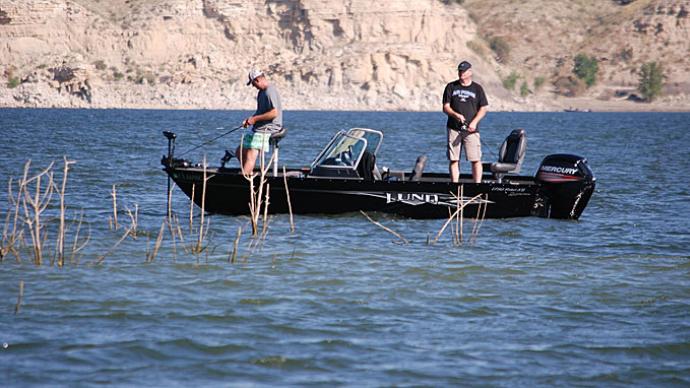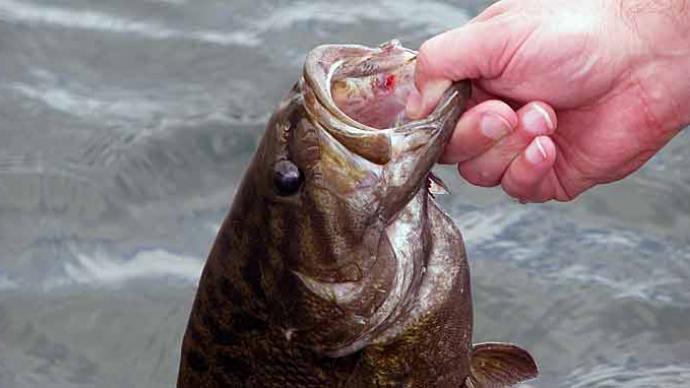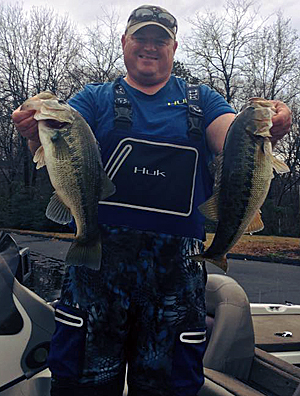
Looking back on his rookie season, Bassmaster Elite Series angler Shane Lineberger said something was missing. Sure, he didn’t get a win, but he rarely had the chance to fish in the wind. The worse weather he remembers was Day two on the upper Mississippi River near Lacrosse, Wis., in September 2016. That day, the wind pushed strong thunderstorms across the region. It also was the day tournament winner Ott Defoe and second-place finisher Seth Feider weighed their heaviest limits.
Lineberger found what he was missing three months later when he fished a team tournament on Lake Norman, which is close to his North Carolina home. That day he felt the wind even before his boat number was called at takeoff. “I was licking my chops,” he said. “I was getting ready to whoop them. We ran around for four hours and never stopped where we didn’t catch at least one fish. I love chasing that wind.”
Like most anglers, you can’t choose your fishing days. You get on the water when family, work, and other responsibilities allow. So regardless of the weather those days bring, you grab your gear and go. That doesn’t mean you aren’t disappointed to see bad weather when you reach the launch ramp, especially a stiff wind. It can make fishing, not to mention the boat rides between spots, miserable. It can cut through the tightest bundled foul-weather gear, chilling you to the bone. But it won’t ruin your day — unless it’s blowing so hard it’s dangerous to be out there — if you use it to your advantage. It will help you catch more and bigger bass.
How wind affects bass
Lineberger always includes the wind in his fishing plans. While other anglers are cursing or hiding from it, he seeks it. He wants to fish where it’s blowing the hardest for one simple reason: The wind makes bass eat. And that starts at the smallest link of the food chain.
From before your grandfather was knee-high to a grasshopper, anglers have been encouraged to fish wind-blown banks. That’s because the common belief was that the wind pushed baitfish onto those spots, and the bass followed them. Lineberger said that’s partly true. Bass do chase baitfish on windy banks. But the baitfish are there because of the microscopic organisms that they eat. They lack fins and can’t swim where they want, so they’re at the mercy of the wind.
Josh Bertrand has felt his share of wind. It’s a common condition on the desert lakes near the Bassmaster Elite Series angler’s Arizona home. He said wind is good for fishing 90 percent of the time, though the particular lake or situation is the deciding factor. The wind is a hindrance during the spawn when a rippled surface makes seeing bass on their beds difficult. The giant waves it creates make finding small offshore spots and staying on them challenging. That’s especially true on the Great Lakes, where he said the wind causes a double whammy. Its giant smallmouth, primarily sight feeders, are more active when conditions are calm, and the sun shines deeper into the water. And strong winds blow in cold fronts, he said, shutting down a hot bite.
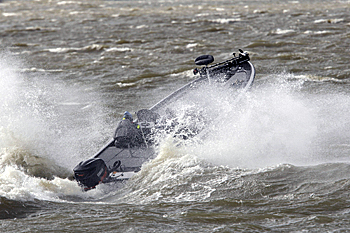
Bertrand said wind is a game-changer on clear lakes, such as Bull Shoals, Table Rock, and Truman in the Ozark Mountains of Arkansas and Missouri. The waves it stacks up hide your presence, muffling the sound of your trolling motor and distorting your silhouette. The reduced light keeps bass from seeing your lure, so they have to bite it to investigate it. And it makes them more comfortable, so swimming around and running down a fast-moving lure is no concern. He regularly sees proof while fishing swimbaits. On a calm day, bass will cautiously follow his lure. They don’t hesitate to bite it on windy days, he said.
Wind also can affect water depth. Seiches occur when a consistent wind, usually over a few days, blows water from one end of a lake to the other. It happens on larger lakes and can change the water level from a few inches to more than a foot, depending on the wind’s fetch and strength. It’s something to keep in mind when you are fishing shallow water. If you are upwind, for example, enough water can be moved out that bass must evacuate your spot.
Adjusting boat control
There are few places to hide from the wind and fish on large lakes. You can run from the wind on inland lakes and rivers, finding a protected bay or creek. That might make your life more comfortable, but the fishing will be more challenging. But it doesn’t have to be that way. You can take advantage of the usually better bite in the wind by adjusting how you control your boat.
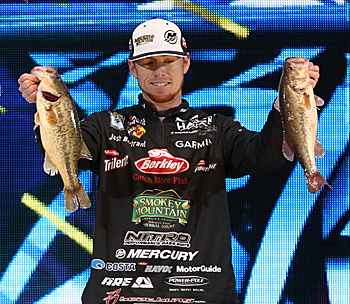
Bertrand fishes into the wind when fishing slow-moving lures, such as jigs or plastic worms, so the boat isn’t blown on top of his lure. Balancing forward movement from the trolling motor and the wind, which is trying to push the boat backward, lets you move at a crawl. That gives your lure as much time as it needs to soak in one spot. It also helps you control the boat. The boat's stern will want to come around when you are trying to fish slowly with the wind. Then you’re spending more time fighting the boat than fishing.
Bertrand said fishing with the wind isn't a problem if you’re throwing a reaction lure, such as a crankbait or bladed jig. You’ll be fishing faster than the wind can move the stern. If you get a few bites on a stretch, turn around and head into the wind, picking apart that water with a slower lure, he said.
Bertrand said it also helps to have your trolling motor properly adjusted. While it’s convenient to have it pulled up, so the blade turns just under the surface when hunting big bites in shallow heavy cover, that setup will make for a long day when it’s windy. Every time the boat climbs a wave, the prop will leave the water. You’ll lose forward momentum and direction if you use a cable-steer model. That means you’ll have to leave your foot on the pedal, which is tiring. So drop it as far as it will go in the mount. You also will have an easier time using just enough continuous power rather than stopping and starting at a more powerful setting, which some anglers claim spooks bass.
GPS waypoints have reinvented offshore bass fishing. They are even more vital when the wind makes it challenging to hold your boat in position. They give you a real-time look at where the boat is in relation to where you want to fish. And when you get blown off while unhooking a bass, they make it easy to return.
When the wind is howling, looking down at your GPS can take enough time and focus on upsetting the boat position. That’s when you need to go old school and pull out a marker buoy. Drop one on your spot, and you’ll have a point of reference that remains in sight while you are casting. If you’re fishing a crowded spot and worried that a brightly colored buoy would draw too much attention from other anglers, use a permanent marker, such as a Sharpie, to color it a darker shade.
Drift socks are one more old-school tool that can salvage windy days. They are a funnel made from nylon fabric. Water enters through the large end and, at a slower rate, exits from the narrow end. When attached to your boat, that drag slows its drift. Current diminishes their effectiveness. They can be tricky to fish around, so tie one from the stern. The eyes where you hang the trailer tie-down straps work well. The paddles attached to Power-Pole shallow-water anchors are a high-tech version of drift socks.
Shallow-water anchors have changed fishing in the wind in other ways. Lineberger said they eliminate the need to fish into the wind. Deploy them, and your boat will remain in one spot, regardless of wind strength. Then you can make a dozen casts at structure and cover within reach without worrying about keeping the boat from drifting onto it. And when you’re done, he said, pull them up, move the boat and repeat the process.
Adjusting tackle and techniques
Probably the biggest hassle with wind involves casting. Getting your lure to its targets is difficult when the wind is strong. Despite a powerful cast, it’s sometimes blown right back to your feet. Lineberger overcomes that by using an underhand roll cast, which moves the lure faster and closer to the water’s surface. “If you cast overhand, you’re sending your lure into the brunt of the wind, which will only push it right back at you,” he said. The cast takes practice to perfect, but the effort will reward you.
Choose a spinning rod if you’re new to or inexperienced with baitcasting reels. They eliminate worries about backlashes. Larger spinning reels made popular because their bigger spools reduce the tight coils that knot fluorocarbon or monofilament lines and easily handle heavier pound tests. Switching to a braided line accomplishes that, too, because they have almost zero memory and smaller diameters.
Bertrand recommends keeping your rod tip close to the water’s surface during your retrieves. That removes any slack line, which the wind can blow into a big bow, making your lure and bites harder to feel.
Choosing a more aerodynamic lure, as long as it fits current conditions and patterns, can make casting in the wind easier. Blades make spinnerbaits, for example, tough to cast in the wind, even with an underhand roll cast. Crankbaits, especially lipless models, are more compact and cut the wind. Plus, they play into the reaction strikes that bass are inclined to give when the water is roiled.
You might be tempted to switch to a heavier version of the lure you’re using, such as going to a ½-ounce spinnerbait from a 3/8-ounce model to overcome the wind. Bertrand doesn’t recommend it because it will likely change your presentation. Adding an eighth ounce to a spinnerbait, as long as the blades, skirt, and trailer remain unchanged, means it will sink more quickly and have to be retrieved faster to maintain the same depth.


